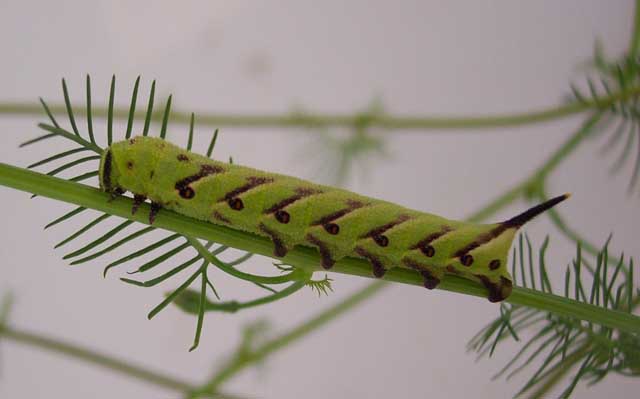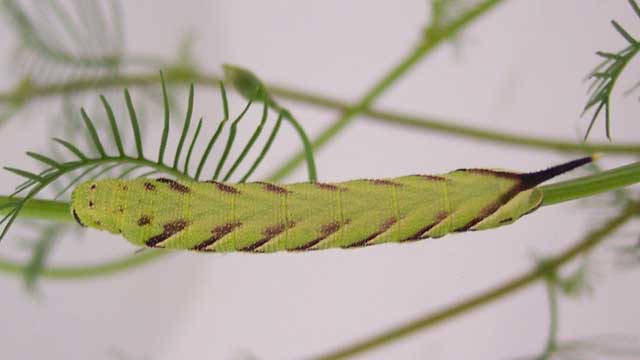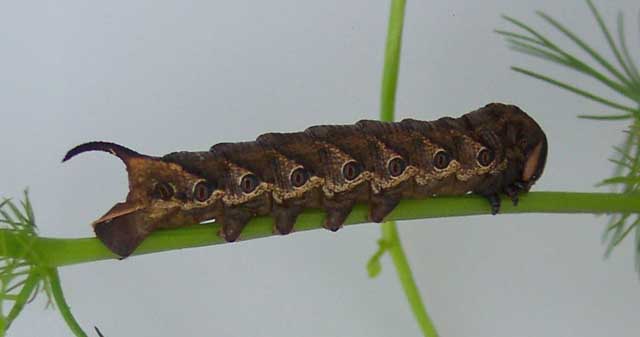Agrius cingulata
Agrius cingulata
ah-GREE-usmm sin-gue-LAY-ta
The Pink-spotted Hawkmoth
(Fabricius, 1775) Sphinx

Agrius cingulata,
third or fourth instar, Georgetown, Williamson County, Texas,
August 25, 2008, courtesy of Jill Burrows.

Agrius cingulata,
third or fourth instar, Georgetown, Williamson County, Texas,
August 25, 2008, courtesy of Jill Burrows.
Jill wrirtes, "I have enjoyed your site and have also used it to identify the few sphinx moths I've raised. I've hit a "dead end" when it comes to the latest
indentification though: I can't remember the exact date I found the eggs and the day they hatched, but I've come across three rather fantastic looking ones.
They are in their 3rd instar, very granulated-looking with straight tails that have a yellow tip. I am in Georgetown, Texas (Williamson County), and the eggs were
found on a cypress vine (Quamoclit pennata). The photos of them were taken yesterday.
"This morning, while gathering food for the unknown three, I found on the same foodsource a completely different caterpillar: very brown, ungranulated, with the tail bending
backwards. This one is a bit larger than the unknown three. I'm sending the photo of this one along as well. Please let me know if they aren't clear enough.
"Thank you for your time. Your help is greatly appreciated! Have a good day."

Agrius cingulata,
fourth or fifth instar, Georgetown, Williamson County, Texas,
August 25, 2008, courtesy of Jill Burrows.
I replied, "All images are of Agrius cingulata which exhibits several different forms.
The green third instars may remain green or they may turn brown in fourth or fifth instar.
Anal horn will become more relaxed in fourth and fifth instars. Granulated appearance will
also vanish.
"Glad you enjoy the site and find it useful. I would like permission to post your images with credit to you??
Thanks for providing data and host plant."
Jill responded, "Sure enough, by the fourth instar, one of the green ones now match the brown one! Thank you so much for the identification.
"You are more than welcome to use the photos, even to alter them to lighten them up if necessary. I just took quick shots to send. I've sent along more photos of other
species I've raised over the past few years: Manduca quinquemaculata (two different color forms in the same brood),
Hemaris diffinis, and a "how-many-can-you-find" one of Xylophanes tersa. The Hemaris one, that one was the only brown form I've ever seen. All the others
I've raised were all green. I think he just turned a darker brown before pupating.
"These are all from Williamson County as well."
This site has been created by
Bill Oehlke at oehlkew@islandtelecom.com
Comments, suggestions and/or additional information are welcomed by Bill.
TAXONOMY:
Family: Sphingidae, Latreille, 1802
Subfamily: Sphinginae, Latreille, [1802]
Tribe: Sphingini, Latreille, 1802
Genus: Agrius Hubner, [1819] ...........
Species: cingulata (Fabricius, 1775)
|
MIDI MUSIC
.....It's a Wonderful World.....
copyright C. Odenkirk
ON.OFF
<bgsound src="world.mid" LOOP=FOREVER>
|
Use your browser "Back" button to return to the previous page.
This page is brought to you by
Bill Oehlke and the
WLSS. Pages are on space rented from Bizland. If you would like
to become a "Patron of the Sphingidae Site", contact Bill.
Please send sightings/images to Bill. I will do my best to respond to
requests for identification help.


